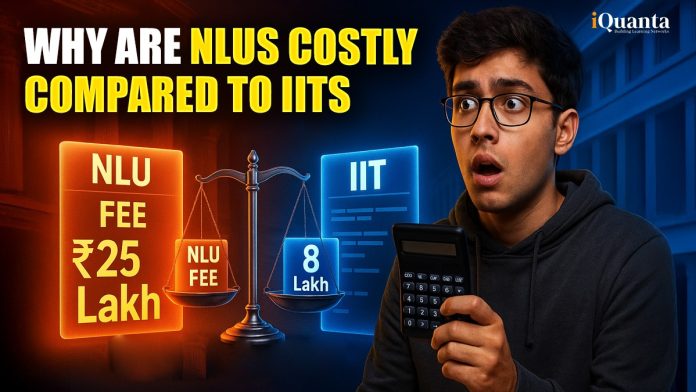National Law Universities (NLUs) and Indian Institutes of Technology (IITs) are the most premier institutions in India and represent excellence in law and technology, respectively. Both sets of educational institutes are known for their rigorous entrance exams, i.e., CLAT (Common Law Admission Test) for NLUs and JEE Advanced for IITs, and their demanding academic environment. However, a contradictory statement exists: Despite IITs offering globally competitive engineering education with top-tier infrastructure and faculty, the fee structure at NLUs is significantly higher than that of IITs. For many aspirants and parents, this cost difference many a time raises a serious question.
In this article, we’ll look into the reasons behind the higher education at NLUs compared to IITs. Our main motive is not just to compare tuition fees but to understand the broader aspect that governs these ecosystems. By the end of this article, you will have a clear picture of why law education in India ends up costing more than premier engineering education. Let’s start.

NLUs vs. IITs: Fee Structure
Let’s begin with the comparative table of the average fee structure of top NLUs and IITs.
| Institute | Course | Total Fee (5 years for NLUs / 4 years for IITs) | Annual Average Fee |
| NLUs | |||
| NLSIU Bangalore | BA LLB | Rs. 18-20 lakhs | Rs. 3.5-4 lakhs |
| NLU Delhi | BA LLB | Rs. 8-10 lakhs | Rs. 1.6-2 lakhs |
| NALSAR Hyderabad | BA LLB | Rs. 12-14 lakhs | Rs. 2.5-3 lakhs |
| IITs | |||
| IIT Delhi | B.Tech | Rs. 8 lakhs | Rs. 2 lakhs |
| IIT Bombay | B.Tech | Rs. 8 lakhs | Rs. 2 lakhs |
| IIT Madras | B.Tech | Rs. 8 lakhs | Rs. 2 lakhs |
Note: Hostel, mess charges, and other expenses are included. The fees may vary slightly every year
The table above depicts that NLUs charge almost double what IITs do over the course of the degree program. Let’s understand this difference in a further blog.
Historical and Structural Reasons
Funding Model: IITs are Centrally Funded, NLUs are State Owned
The most accurate difference between NLUs and IITs lies in the source of funding. IITs are centrally funded institutes through the Ministry of Education (MoE), which provides a major source of their financial resources, which covers faculty salaries, infrastructure, maintenance, research, and even student scholarships.
On the other hand, NLUs are funded and also governed by individual state governments of the respective NLU, like NLSIU is under the Karnataka Government, NALSAR is under the Telangana Government, and WBNUJS is under the West Bengal Government. The central government does not provide any funds or grants to NLUs, which results in limited and inconsistent funding from the state, increasing the costs significantly.
NLUs Have Lesser Economies of Scale
Indian Institutes of Technology (IITs) usually have larger student intakes across multiple disciplines (engineering, science, humanities, management, etc.), allowing them to spread infrastructure costs and operational expenses. On the other hand, NLUs admit students in the undergraduate law program, which leads to higher per-student costs.
Faculty Salaries & Law Education Cost
Law education involves high investment in legal databases, courtroom labs, and interaction with practicing law professionals, many of whom charge high consulting fees for guest lectures. While IITs also have top-paid faculty, their operational costs are subsidized. NLUs cover the basic faculty salaries and legal resource subscriptions through internal revenue only.
Breakdown Of NLUs Expenses
Let’s look at the NLUs expense breakdown.
| Cost Component | Details |
| Academic Fee | Include tuition fees, moot court labs, library access, research material |
| Hostel & Mess | Fully residential campuses require separate hostel and food fees |
| Infrastructure Maintenance | Legal campuses require seminar halls, law libraries, digital labs |
| Faculty & Staff Salaries | Paid without central government assistance |
| Event and Moot Funding | National/International moot competitions, debates, conferences |
| Lack of Endowments | Unlike IITs and IIMs, most NLUs don’t have rich alumni or corporate endowments yet |
Is the Return on Investment (ROI) Worth It?
When students invest Rs. 15-20 lakh for a law degree, they naturally expect more returns. Let’s look at the average placements:
Average Salary (CTC) for Top NLUs:
| NLUs | Average CTC | Top Law Firms |
| NLSIU | Rs. 16-18 LPA | Shardul Amarchand, AZB, Khaitan, Trilegal |
| NALSAR | Rs. 15-17 LPA | CAM, SAM, L&L Partners |
| NLU Delhi | Rs. 15-16 LPA | S&R, JSA, Talwar Thakore |
Average Salary (CTC) for IITs (B.Tech)
| IITs | Average CTC | Top Recruiters |
| IIT Bombay | Rs. 21-25 LPA | Google, Microsoft, Amazon, Goldman Sachs |
| IIT Madras | Rs. 20-22 LPA | Qualcomm, Adobe, Morgan Stanley |
| IIT Delhi | Rs. 20-24 LPA | Uber, Oracle, Accenture |
From the table above, you can observe that IITs are still ahead in terms of average packages and international offers. However, top NLUs are not far behind when it comes to domestic legal placements. The challenge was there for lower-ranked NLUs, where the fee structure remains high but placements are moderate.
Government Subsidies: Why IITs Benefit More
IITs:
- IITs receive annual grants from the Central Government (MoE).
- IITs participate in research collaborations that bring in additional funds from CSIR, DST, and other international bodies.
- IITs also enjoy fee waivers for SC/ST/PwD students and income-based scholarships sponsored by government schemes.
NLUs:
- The state government doesn’t provide much support due to lack of funds.
- Many states delay or ignore the promised grants, which makes the universities financially unstable.
- Scholarships in NLUs are limited and cover only partial costs.
Suggested Reforms to Make NLUs Affordable
Here are some suggested reforms that can make NLUs affordable for students who want to secure their future in the law discipline.
- Centralized Funding Model: Similar to the MHRD’s education budget for IITs and IIMs, introduce a National Legal Education Fund for NLUs.
- Stronger Alumni Network: Encourage NLUs alumni to contribute to endowment funds that can be used for scholarships and infrastructure.
- Industry-Academia Partnership: NLUs must collaborate with law firms, corporations, and bar councils to sponsor research grants, chairs, and student scholarships.
- Standardize Fee Regulations Across NLUs: A regulatory body must set upper limits on NLU fee hikes and bring transparency in resource usage.
- More Government Subsidies for Legal Education: As done for IITs and IIMs, recognize NLUs as institutions of national importance and provide direct aid.
Join CLAT Course

Conclusion
The notion that NLUs are more expensive than IITs is not just based on tuition numbers but is a reality rooted in systemic funding differences, administrative challenges, and the lack of central government support. NLUs are left to feed themselves financially, while IITs benefit from government investment, research backing, and national-level planning, leading NLUs to depend on student fees.
If India wants to produce more world-class lawyers just as it has its engineers and tech entrepreneurs, then law education needs the same level of policy formulation, subsidies, and long-term planning. Making legal education affordable doesn’t mean reducing the fees; it’s about recognizing that law too is a nation-building profession that deserves public investment.




